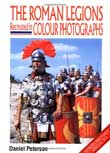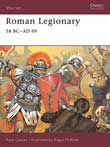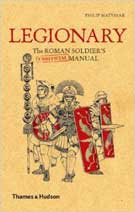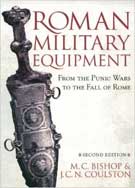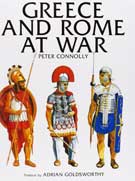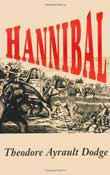

Ancient Empires
Ancient periods of time, while it was so long ago, there is also SO much written. for those who reenact these older periods, there ARE no photos, so you have to look at statuary and art that is left. In your quest for information, we have found some great books. Give 'em a look. Books... most reenactors have huge libraries and this period deserves no less... The first section here are books directly useful to the reenactor, not having so much emphasis on rusted bits of metal and their interpretation as others do. Scholarly works are fine, but not always the best for the reenactor.
And yeah, in many ways, we are "Osprey-heavy"... why? Because they serve a good purpose; not only to give one a good grounding in a subject, but also they have COLOR plates, which make things come alive. Part of being a reenactor is to live the past and you can't do that well with bad old drawings--history was in color.
YOU HAVE TO BUY THIS BOOK FIRST!
It is, without a doubt, the best thing for the reenactor to get, as it shows full-color photos of Roman reenactors!
If the movie "Gladiator" shows Roman troops in all their glory on the big screen, "The Roman Legions: Recreated in Colour Photographs" captures all this glory in a book. The photos contained in this book are the marching Roman recreations you see on The Learning Channel, PBS, Discovery, and other educational TV shows. The author, Daniel Peterson, is a military historian and a museum curator and is also the organizer for the largest and most accurate recreations of the Roman military life. He's a member of the world's only authentically reconstructed Roman Calvary unit and in his personifying role has lived, marched, and ridden hundreds of miles across what was once the Roman Empire. His unit is authentically armored and equipped and prepares and eats authentic rations during their outings as Roman Legions. It goes without saying that his book is just as he envisioned it down to the last detail.
Suffice to say, the photos are absolutely stunning! There are hardly any drawings, paintings, or "historical art" in this book; that is all photos of Roman gear and equipment are real replicas and are worn by real humans. Front and back views are presented of Legionnaires, Calvary, Standard Bearers, Centurions, and auxiliary infantrymen. There are plenty of close-ups and detail shots of daggers, helmets, chain main, link plate, shields, and siege engines. Best of all, there are photos showing Legions marching, in formation, defending, and setting up defenses. There are no enemy actors in the photos so someone looking of battle scenes or how Rome's enemies look like will have to use other books.
This book has a brief history of the Roman Empire and also shows gear worn by early (BC) and later (300AD) Romans troops. However, the main focus of this book is showing Roman soldiers at the height of the Roman Empire: 1AD-200AD, or the traditional Legionary and Centurion with the red tunic and chrome plate body armor we often remember.
BUY THIS BOOK SECOND!
What I like about htis book, is that it tell sabout the soldier's LIFE, not just battles or his kit. The puffy people will look down their noses at Osprey books, but I tend to like them for the reenactor. Sure, you can buy books with more detail, but to start, to get a feel for the book, you need this! Buy it, you won't go wrong.
Publisher's description: The period 31 BC-AD 43 saw the greatest expansion of the Roman Empire. In 31 BC Octavian defeated Antony at the battle of Actium and remodelled the semi-professional Roman army into a permanent force of 28 legions. Octavian became the first emperor (Augustus) and under his leadership the legions conquered northern Spain, all Europe south of the Danube line and Germany west of the Elbe. The legionaries exemplified the heroic culture of the Roman world and this title takes a behind-the-scenes look at their lives, training, weaponry and tactics, including the bloody massacre of the Teutoberg forest.
A great book that puts the information there in an easy to understand, yet humerous manner. Is it deep? No. Is it supposed to be? No. This book DOES, however, impart some really good knowledge about the Legions and their soldiers. And it really is, kind of like a soldier's handbook.
Publisher's description: This carefully researched yet entertainingly unacademic book tells you how to join the Roman legions, the best places to serve, and how to keep your armor from getting rusty. Learn to march under the eagles of Rome, from training, campaigns, and battle to the glory of a Roman Triumph and retirement with a pension plan.
Every aspect of army life is discussed, from drill to diet, with handy tips on topics such as how to select the best boots, or how to avoid being skewered by enemy spears. 15 color, 25 b&w illustrations
Rome's rise to empire is often said to have owed much to the efficiency and military skill of her armies and their technological superiority over barbarian enemies. But just how 'advanced' was Roman military equipment? What were its origins and how did it evolve? The authors of this book have gathered a wealth of evidence from all over the Roman Empire—excavated examples as well as pictorial and documentary sources—to present a picture of what range of equipment would be available at any given time, what it would look like and how it would function. They examine how certain pieces were adopted from Rome's enemies and adapted to particular conditions of warfare prevailing in different parts of the Empire. They also investigate in detail the technology of military equipment and the means by which it was produced, and discuss wider questions such as the status of the soldier in Roman society. Both the specially prepared illustrations and the text have been completely revised for the second edition of this detailed and authoritative handbook, bringing it up to date with the very latest research. It illustrates each element in the equipment of the Roman soldier, from his helmet to his boots, his insignia, his tools and his weapons. This book will appeal to archaeologists, ancient and military historians as well as the generally informed and inquisitive reader.
One of the "Standards" in studying the Greeks and Romans. Really great illustrations and even photos of the battlefields in the present day. Worth every penny!
Publisher's description: In this sumptuous guide to twelve centuries of military development, the late Peter Connolly combines a detailed account of the arms and armies of Greece and Rome with his superb full-color artwork. Making use of fresh archeological evidence and new material on the manufacture and use of the weapons of the period, the author presents an attractive and impressive volume that is both scholarly and beautifully presented with illustrations that are, quite rightly, recognized as being the best and most accurate representation of how the soldiers from these formidable military empires appeared.Greece and Rome at War lucidly demonstrates the face of battle in the ancient world. Covering the wars between the Greeks and the Persians and the epic contest between the Romans and their most capable opponent, Hannibal, as well as organization, tactics, armor and weapons, and much more, this excellent work brings the armies of Greece, Macedon and Rome vividly to life. This new revised edition contains a Preface by Adrian Goldsworthy.
Hannibal is often considered the finest general the world has ever known. Setting out from Carthaginian-dominated Spain with a small army of select troops, he fought his way over the Pyrenees and crossed the Alps with elephants and a full baggage train. Descending into Italy, he destroyed the main Roman army at Lake Trasimeno and came close to conquering Rome itself. At Cannae, Hannibal's brilliant cavalry tactics enabled him to cut to pieces a reassembled Roman army, and his subsequent defeats over a fifteen-year stay in Italy were due more to lack of sufficient support from home than to any failings of generalship.T. A. Dodge's classic history, first published in 1891, is equally perceptive of Hannibal's military prowess and his visionary character. Dodge followed Hannibal's route from Carthage to Italy, paying particular attention to the famous crossing of the Alps, exploring every pass in order to determine Hannibal's route. In this book, he wrote an entire history of the art of war among these two mighty armies and included hundreds of invaluable illustrations. Hannibal remains unequaled as the most comprehensive and readable study of history's greatest general.
Pope Julius II excommunicates Italian state of Venice
Treaty of St. Truiden: anti-French Trapdoors / Bourgondisch covenant
Battle at Bicacca: Charles I and Pope Adrianus VI beat France
Mogol King Babur beats Sultan of Delhi
1st Spanish settlement in Philippines, Cebu City, forms
Peace of Beaulieu and Paix de Monsieur
King Charles I flees Oxford
Scottish general Montrose defeated
Netherlands and France sign military covenant
Frederik August I "the Strong" becomes Monarch of Saksen
Battle at Culloden Moor: Duke of Cumberland beats "James VIII & III"
US Marines attack shores of Tripoli
Americans under General Pike capture Toronto; Pike is killed
Fire destroys half of Charleston
Imakita Kosen, 1st Zen teacher of D.T. Suzuki, found the awakening
Establishment of Jewish congregations in Lower Austria prohibited
"Pomona" sinks in North Atlantic drowning all 400 aboard
Thomas J Jackson is assigned to command Harpers Ferry
President Abe Lincoln suspends writ of habeas corpus
West Virginia secedes from Virginia after Virginia secedes from US
Cornell University (Ithaca NY) is chartered
Heinrich Schliemann discovers Troi
White League, Paramilitary white supremacist organization, forms
Opera "Le Roi de Lahore" is produced (Paris)
President Hayes removes Federal troops from LA, Reconstruction ends
Pogroms against Russian Jews start in Elisabethgrad
1st Highlander (Yankee) shut-out, Philadelphia Athletics win 6-0
World Exposition opens in Luik
Sultan of Turkey Abdul Hamid II is overthrown
Belgian parliament rejects socialist motion for general voting rights
Relief laws replaces those of 1854, in the Netherlands
Pogrom leader Petljoera declares Ukraine Independence
Hadjememaar, [Corn de Gelder] elected in Amsterdam
Fritz Langs "Dr Mabuse, der Spieler" premieres in Berlin
Yakut ASSR formed in Russian SFSR
Mussolini government italian place in South Tirol / Alto Adige
Antwerp soccer tie Belgium-Netherlands 1-1
Karl Jansky reports reception of cosmic radio signal in Washington DC
Yanks pull a 1st inning triple-play and beat Philadelphia Athletics 9-8
1st US social security payment made
US Social Security system makes its 1st benefit payment
Himmler orders establishment of Auschwitz Concentration Camp
German troops occupy Athens Greece
Belgium Jews are forced to wear stars
Tornado destroys Pryor Oklahoma killing 100, injuring 300
Lou Jansen and Jan Dieters arrested, lead illegal CPN party in Holland
Soviet Union breaks contact with Polish government exiled in London
Boston Brave Jim Tobin no-hits Brooklyn Dodgers, 2-0
2nd Republic of Austria forms
Italian partisans capture Mussolini prisoner
US 5th army enters Genua
1st radar installation aboard a coml ship installed
Babe Ruth Day celebrated at Yankee Stadium and through out US
Arab legion attacks Gesher bridge on Jordan River
"Tickets, Please" opens at Coronet Theater NYC for 245 performances
South Africa passes Group Areas Act segregating races
Mohammed Mossadeq chosen Premier of Persia
"4 Saints in 3 Acts" closes at Broadway Theater NYC after 15 performances
1st general elections in British Guyana, won by Jagans PPP
Wrestler Freddie Blassie coins term "Pencil neck geek"
Heavyweight champ, Rocky Marciano, retires undefeated from boxing
"Today" show goes abroard 1st time (Paris France)
Liu Sjau-chi elected President of China PR
1st atomic powered electric-drive submarine launched (Tullibee)
South Korean President Syngman Rhee resigns
Togo (formerly French Togo) declares independence from French adm
NASA launches Explorer 11 into Earth orbit to study gamma rays
NFL officially recognizes Hall of Fame in Canton, Ohio
Sierra Leone declares independence from the UK
"Jopie" Pengel forms government in Suriname
Cuban Premier Fidel Castro arrives in Moscow
RC Duncan patents "Pampers" disposable diaper
Dmitri Shostakovitch completes his 2nd cello concert
Rocky Marciano retires as undefeated boxing champ
"Education of Hyman Kaplan" closes at Alvin NYC after 28 performances
Baltimore Oriole Tom Phoebus no-hits Boston, 6-0
Congress of Political Party Radicals (PPR) forms in the Netherlands
Carol Mann wins LPGA Raleigh Ladies Golf Invitational
Curt Flood resigns Senators after 13 games and departs for Denmark
Apollo 16 returns to Earth
New York City Mayor John Lindsey appeals that John Lennon not be deported
Kansas City Royal Steve Busby no-hits Detroit Tigers, 3-0
Pan Am 707 crashes into mountains of Bali, killing 107
Sandra Haynie wins LPGA Charity Golf Classic
"So Long 174th St" opens at Harkness Theater NYC for 16 performances
Arabic Monetary Fund established in Abu Dhabi
Bloody riots in Soweto South Africa
HCC, Hobby Computer Club, forms in the Netherlands
Accident at nuclear reactor Willow Island, W Virginia, kills 51
George Harrison releases "Love Comes to Everyone"
Barbara Barrow wins LPGA Birmingham Golf Classic
1st female soccer official is hired by NASL
Beatle Ringo Starr marries actress Barbara Bach [Goldbach]
Nordiques 1-Isles 4 - Semifinals - Isles hold 1-0 lead
Trial of John W Hinckley Jr attempted assassin of Reagan, begins
Nolan Ryan becomes strikeout King (3,509), passing Walter Johnson
Cleveland Indians beat Detroit Tigers, 8-4, in 19 innings
Over 70 inches of snow falls on Red Lake, Montana
"Sweet Charity" opens at Minskoff Theater NYC for 368 performances
Captain Midnight (John R MacDougall) interrupts HBO
Pat Bradley wins LPGA S&H Golf Classic
US Justice Department bars Austrian Chancellor Kurt Waldheim from entering US, due to his aid of Nazi Germany during WWII
"Starmites" opens at Criter Ctr SR Theater NYC for 60 performances
Beijing students take over Tiananmen Square in China
Hurricane in Bangladesh, kills 500
Mandatory seatbelt law goes into effect in Italy
50th annual barbershop quartet singing convention held (Mich)
Dodger Orel Hershiser undergoes career-threatening shoulder surgery
Firestone World Bowling Tournament of Champions won by David Ozio
"Small Family Business" opens at Music Box Theater NYC for 48 performances
New York Jets finish perfect 5-0 pre-season for 1st time
New York Mets trade David Cone to Toronto Blue Jays for Jeff Kent
Afghan Antonov AN-32 crashes at Tashqurgan, kills 76
"Inspector Calls" opens at Royale Theater NYC for 454 performances
7th longest NHL game: New Jersey Devils beat Buffalo Sabres (125 min 43 seconds)
Graeme Obree bicycles world record time (52,713 km)
President Nixon buried in Nixon Library in California
Twins righty Scott Erickson no-hits Brewers 6-0
"Indiscretions" opens at Ethel Barrymore Theater NYC for 221 performances
Coors Field in Colo opens - Denver Rockies beats Mets 11-9 in 14
"Little Foxes, " opens at Vivian Beaumont NYC for 56 performances
"Stanley, " closes at Circle in the Square Theater, New York City
Frank Nobilo wins Greater Greensboro Chrysler Classic at Forest Oaks
Las Vegas Senior Golf Classic by TruGreen-ChemLawn
Nancy Lopez wins LPGA Chick-fil-A Charity Championship
